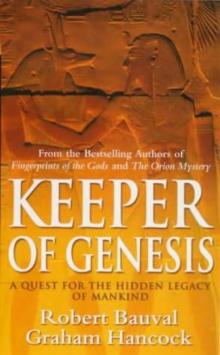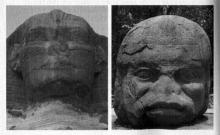- Home
- Graham Hancock
The Message of the Sphinx AKA Keeper of Genesis Page 5
The Message of the Sphinx AKA Keeper of Genesis Read online
Page 5
Again, we do not have a technical study on the Sphinx and Valley Temples to refer to. Fortunately, however, a relevant study has been undertaken at the Great Pyramid where the French master engineer Jean Leherou Kerisel, a consultant for the building of the Cairo Metro, worked out the logistics of hauling into place the 70-ton blocks that were used in the construction of the so-called King’s Chamber. According to his calculations the job could just about have been done—although with enormous difficulty—with teams of 600 men arranged in ranks across a very wide ramp buttressed against one face of the Pyramid.[72] From this it follows that teams 1800 men strong would have been required to haul the Valley Temple blocks. But could 1800 men have been effectively harnessed to such dense and relatively compact loads (the maximum dimensions of each block are 30 feet by 10 feet by 12 feet)? And more to the point, since the temple walls do not exceed 130 feet along each side, how likely is it that such large teams could have been organized to work efficiently—or at all—in the limited space available? Assuming a minimum of three feet of horizontal space per man, each rank of haulers could not have contained more than fifty men. To make up the total of 1800 men needed to move a 200-ton block, therefore, would have called for no less than thirty-six ranks of men pulling in unison, to be harnessed to each block.
The potential complications that might have arisen are mind-boggling. Even assuming they could all have been overcome, however, the next question that presents itself is perhaps the most intriguing of all.
Why?
Why bother?
Why specify temples built out of unwieldy 200-ton blocks when it would have been much easier, much more feasible and just as aesthetically pleasing, to use smaller blocks of say two or three tons each?
There are really only two answers. Either the people who designed these hulking edifices had knowledge of some technique that made it easy for them to quarry, manipulate and position enormous pieces of stone, or their way of thinking was utterly different from our own—in which case their motives and priorities are unlikely to be fathomable in terms of normal cross-cultural comparisons.
We also need to ask when the work was done.
As noted earlier, the Sphinx Temple and the Valley Temple are both anonymous monuments. And although it is certain that use was made of the latter for Khafre’s funerary rituals, there is no proof that he built it. On the contrary, if Professor Robert Schoch’s geological evidence is correct, then it is quite certain that Khafre did not build either of these structures. This is so because the Sphinx itself was made by hewing a deep horseshoe-shaped trench out of the bedrock of the Giza plateau, leaving a central core which was then carved into shape, and because geologists have been able to prove that the limestone megaliths used in both temples came from the trench and were thus quarried at the same time as the Sphinx.[73] It therefore follows, if the Sphinx is indeed thousands of years older than Egyptologists think it is, that the temples must also be thousands of years older.
What we may be looking at here are the fingerprints of highly sophisticated and perhaps even technological people capable of awe-inspiring architectural and engineering feats at a time when no civilization of any kind is supposed to have existed anywhere on earth.
Supportive of this possibility is the fact that the megaliths of the temples demonstrate precisely the same apparent precipitation-induced weathering features as the Sphinx itself. And it is of interest to note that the surviving granite casing blocks seem to have been carved on their inner faces to fit over the limestone core-blocks at a time when these were already heavily marked by erosion. Since the granite casing has the look of other Old Kingdom Egyptian architecture (while the limestone core-blocks do not) this may be taken as further evidence of the theory that an ancient, revered and much-eroded structure was restored and renovated by the Old Kingdom Pharaohs. Robert Schoch certainly favours this view. ‘I remain convinced,’ comments the Boston University geology professor, ‘that the backs of the Old Kingdom granite facing stones were carved to match or complement the earlier weathering features seen on the surfaces of the core limestone blocks of the temples.’[74]
Memorials mighty
The famous black diorite statue of Khafre that now stands in the Cairo Museum was found upside down in a twenty-foot deep pit in the floor of the antechamber that leads into the Valley Temple’s T-shaped central hall. Walking through this hall, hemmed in by immensely strong and thick limestone and granite walls, the visitor will eventually come to a high, narrow passageway on the north-western side of the structure. This passage leads out of the rear of the temple, along the southern side of the Sphinx trench—where it overlooks the Sphinx—and thence joins with the massive ‘causeway’ that runs for more than 1000 feet up the slope of the Giza plateau linking the Valley Temple to the Mortuary Temple and thence to the eastern face of the second Pyramid.
The causeways—one for each of the three Pyramids—are important features of the Giza necropolis, though all have fallen into an advanced state of disrepair. Some 20 feet wide, and varying in length from quarter of a mile up to half a mile, they each originally linked a Mortuary Temple to a Valley Temple. Today, however, the only relatively intact complex is that attributed to Khafre described above. In the case of the third Pyramid, the Valley Temple is now completely gone but the megalithic ruins of the Mortuary Temple are still in place. In the case of the Great Pyramid the only remaining part of the Mortuary Temple is its basalt floor, while the ruins of the Valley Temple—if any survive—are buried under the village of Nazlet-el-Sammam.
The three causeways, like the Mortuary and Valley Temples, are fashioned out of huge blocks of limestone. Indeed all of these prodigious structures are clearly ‘of a piece’ from a design point of view and seem to have been the work of builders who thought like gods or giants. There is about them an overwhelming, weary, aching sense of antiquity and it is certainly not hard to imagine that they might be the leavings of a lost civilization. In this regard we are reminded of The Sacred Sermon, a ‘Hermetic’ text of Egyptian origin that speaks with awe of lordly men ‘devoted to the growth of wisdom’ who lived ‘before the Flood’ and whose civilization was destroyed: ‘And there shall be memorials mighty of their handiworks upon the earth, leaving dim trace behind when cycles are renewed ...’[75]
4. The artificial ‘Horizon of Giza’.
There is another feature of the causeways, of intense interest to us, which we shall explore in detail in Parts III and IV—their orientation. The causeway of the Third Pyramid, like the gaze of the Sphinx, is targeted due east. The causeway of the second Pyramid points 14 degrees south of due east. The causeway of the Great Pyramid points 14 degrees north of due east. The arrangement is precise, geometrical, obviously deliberate, with each significant structure bearing a designed relationship to every other structure—and the whole contained within a large, circular artificial ‘horizon’ that is apparently centred on the apex of the second Pyramid with its rim lying just to the west of the rump of the Sphinx.
Orthodox Egyptological opinion concerning the causeways is that they were ceremonial roads. Notwithstanding the fact that they are technological masterpieces which could only have been built with an enormous expense of ingenuity and effort at the direction of skilled surveyors and architects, the assumption is that they were used just once for the funerary journey of the Pharaoh’s corpse from Valley Temple to Mortuary Temple where his final embalming rituals took place.
Perhaps so. As we shall show in Parts III and IV, however, there are features of these causeways which suggest that they may have been used many times by many different Pharaohs and that they have their technical and symbolic origins in events that occurred long before the dawn of the historical civilization of Egypt.
Not purely symbolic boats
In the 1850s Sir Richard Francis Burton, the British explorer and adventurer, visited Egypt and the Pyramids of Giza. He noted some odd ‘rhomboidal depressions’ lying parallel to the eastern side of the Great Pyramid
, close to the end of its causeway, and made sketches of them which are now kept in the British Museum.[76] Some years later, in 1881, Sir William Flinders Petrie, the ‘Father of British Egyptology’, also saw these strange depressions but simply referred to them as ‘trenches’ and did not bother to have them cleared.[77]
In 1893, buried in pits near a relatively obscure pyramid on another site, the famous French Egyptologist de Morgan discovered six large wooden boats, but little was made of this. In 1901 another French Egyptologist, Chassinat, discovered a ‘rhomboidal pit’ near the pyramid of Djedefra at Abu Roash. After noting that it very much resembled the pits at Giza near the Great Pyramid, he wrote: ‘their purpose is unknown, as is the case here.’[78]
Ancient Egyptian funerary texts are strewn with references to boats—notably the various solar and divine vessels on which the deceased hoped to voyage in the cosmic afterlife (the ‘boat of millions of years’ for example, the ‘bark of Osiris’, and the ‘bark of Ra’). Carvings, drawings and paintings of such ‘boats’ and ‘barks’, with their characteristic high prows and sterns, adorn the walls of many an ancient tomb in Egypt and their symbolic and religious functions were understood well before the close of the nineteenth century. Nevertheless it was only when the German archaeologist Ludwig Borchardt excavated an obvious and unmistakable boat made of bricks near the sun-temple and pyramids at Abusir, that it was recognized that the mysterious ‘rhomboidal pits’ were in fact boats—or at any rate representations of boats, or graves for boats.
Since Borchardt’s time, several other boat pits have been found—by Selim Hassan in 1933, for example, and by Walter Emery in 1937. Finally, in 1954, Kamal el-Mallakh discovered something quite breathtaking—a partially disassembled cedarwood boat, more than 143 feet long, buried in a pit on the south side of the Great Pyramid. Much more recently another vessel of similar dimensions has been located in an adjacent pit. As yet unexcavated, it is apparently to be studied by a Japanese consortium.
The fact that Egyptologists took a long time to notice that there were large boats buried at Giza does not necessarily mean that their analysis of the function of these boats is completely wrong. The idea is that the majestic vessels were intended in some ‘primitive’, ‘magical’, ‘superstitious’, ‘half-savage’ way to serve as symbolic vehicles on which the souls of dead Pharaohs could sail into Heaven. This interpretation is consistent with the ancient Egyptian funerary texts and there can be little doubt that the boats—‘solar boats’ as the Egyptologists call them—were indeed intended to play a part in symbolic celestial journeys. As we shall see in Parts III and IV, however, it is possible that the precise nature and purpose of those journeys may have been much more complex and significant than has hitherto been recognized.
Meanwhile, standing in front of the ‘solar boat’ excavated from beside the south face of the Great Pyramid in 1954 it is hard not to note the marks of wear and tear on the keel and gangplank and the numerous other clear signs that this elegant cedarwood vessel, with its high curving prow and stern, was sailed many times on water.[79]
If it was purely symbolic, why was it used?
And why was it necessary to have such an elaborate and technically accomplished[80] craft for symbolic purposes? Wouldn’t a symbolic vessel—such as the brick boats and boat ‘graves’ found at other Pyramids—have done just as well?
The Pyramids
The dominant features of the Giza necropolis are, of course, its three great Pyramids—those conventionally attributed to Khufu, Khafre and Menkaure. In a sense they are what the entire, vast enterprise proclaims itself to be all about, what the causeways lead towards, what the ‘solar boats’ are buried beside. Sprawling diagonally across the meridian axis of the site, it is they, above all else, that the geometrical ‘Horizon of Giza’ appears to have been designed to circumscribe. Nothing about them is accidental: their original constructed heights, their angles of slope, the measurement of their perimeters, even the pattern in which they are carefully laid out on the ground—all of these things are purposive and laden with meaning.
Because we have described the Pyramids in such detail in other publications[81]—where we have also looked in depth into many of their technical and engineering puzzles—we will not trouble the reader with superfluous details here. Some basic statistics and a few points of analysis are, however, unavoidable at this stage.
The Great Pyramid was originally 481.3949 feet in height (now reduced to just a little over 450 feet) and its four sides each measure some 755 feet in length at the base. The second Pyramid was originally slightly lower—with a designed height of 471 feet—and has sides measuring just under 708 feet in length. The third Pyramid stands some 215 feet tall and has a side length at the base of 356 feet.
When they were built the second Pyramid and the Great Pyramid were both entirely covered in limestone facing blocks, several courses of which still adhere to the upper levels of the former. The Great Pyramid, by contrast, is today almost completely bereft of its casing. We know from historical accounts, however, that it was once clad from bottom to top with smoothly-polished Tura limestone which was shaken loose by a powerful earthquake that devastated the Cairo area in ad 1301. The newly exposed core masonry was then used for some years as a crude local quarry to rebuild the shattered mosques and palaces of Cairo.
All the Arab commentators prior to the fourteenth century tell us that the Great Pyramid’s casing was a marvel of architecture that caused the edifice to glow brilliantly under the Egyptian sun. It consisted of an estimated 22 acres of 8-foot-thick blocks, each weighing in the region of 16 tons, ‘so subtly jointed that one would have said that it was a single slab from top to bottom’.[82] A few surviving sections can still be seen today at the base of the monument. When they were studied in 1881 by Sir W. M. Flinders Petrie, he noted with astonishment that ‘the mean thickness of the joints is 0.020 of an inch; and, therefore, the mean variation of the cutting of the stone from a straight line and from a true square is but 0.01 of an inch on a length of 75 inches up the face, an amount of accuracy equal to the most modern opticians’ straight-edges of such a length.’
Another detail that Petrie found very difficult to explain was that the blocks had been carefully and precisely cemented together: ‘To merely place such stones in exact contact at the sides would be careful work, but to do so with cement in the joint seems almost impossible ...’[83]
Also ‘almost impossible’, since the mathematical value pi (3.14) is not supposed to have been calculated by any civilization until the Greeks stumbled upon it in the third century bc,[84] is the fact the designed height of the Great Pyramid—481.3949 feet—bears the same relationship to its base perimeter (3023.16 feet) as does the circumference of any circle to its radius. This relationship is 2pi (i.e. 481.3949 feet x 2 x 3.14 = 3023.16 feet).
Equally ‘impossible’—at any rate for a people like the ancient Egyptians who are supposed to have known nothing about the true shape and size of our planet—is the relationship, in a scale of 1:43,200, that exists between the dimensions of the Pyramid and the dimensions of the earth. Setting aside for the moment the question of whether we are dealing with coincidence here, it is a simple fact, verifiable on any pocket calculator, that if you take the monument’s original height (481.3949 feet) and multiply it by 43,200 you get a quotient of 3938.685 miles. This is an underestimate by just 11 miles of the true figure for the polar radius of the earth (3949 miles) worked out by the best modern methods. Likewise, if you take the monument’s perimeter at the base (3023.16 feet) and multiply this figure by 43,200 then you get 24,734.94 miles—a result that is within 170 miles of the true equatorial circumference of the earth (24,902 miles). Moreover, although 170 miles sounds quite a lot, it amounts, in relation to the earth’s total circumference, to a minus-error of only three quarters of a single per cent.
High precision
Such fine errors are within the general margins of tolerance found at the Great Pyramid. Indeed, although i
t has a footprint of over 13 acres, and consists of some six and a half million tons of limestone and granite blocks, the sheer mass and size of this monster of monuments are not its most impressive characteristics. More astounding by far is the incredible high-tech precision that is built into every aspect of its design.
Before going into the details, let us consider the implications of very fine precision in very large monuments.
An analogy with the simple wrist-watch helps. If you are after an accuracy of, say, a few seconds per week, then an ordinary quartz watch costing fifty dollars or less will do the trick. If you want accuracy to within a fraction of a second per year, however, then the quartz watch will no longer serve and you will have to turn to something of the order of an atomic clock.
A similar situation applies in the construction industry. If you are building a brick wall that is to appear straight within plus or minus 1 degree per 100 metres and the whole roughly directed due north, then any good bricklayer should be able to meet your specification. However, if your requirement is for a wall that is straight within 1 arc minute per 100 metres and directed exactly due north, then you are going to need a laser theodolite, an ordnance survey map accurate to 10 metres, and a highly qualified team of professionals including an expert setting-out engineer, an astronomer, a surveyor, several master-masons and a week or so to ensure that the precision you are aiming for has in fact been achieved.
Such ‘atomic clock’ precision was achieved by the builders of the Great Pyramid more than 4500 years ago. This is not a matter of historical speculation, or of theory, but of plain, measurable facts.

 Underworld: The Mysterious Origins of Civilization
Underworld: The Mysterious Origins of Civilization The Master Game: Unmasking the Secret Rulers of the World
The Master Game: Unmasking the Secret Rulers of the World America Before
America Before Entangled
Entangled War God: Nights of the Witch
War God: Nights of the Witch War God: Return of the Plumed Serpent
War God: Return of the Plumed Serpent The Message of the Sphinx AKA Keeper of Genesis
The Message of the Sphinx AKA Keeper of Genesis Fingerprints of the Gods
Fingerprints of the Gods The Sign and the Seal
The Sign and the Seal The Mars Mystery: The Secret Connection Between Earth and the Red Planet
The Mars Mystery: The Secret Connection Between Earth and the Red Planet Magicians of the Gods: The Forgotten Wisdom of Earth's Lost Civilization
Magicians of the Gods: The Forgotten Wisdom of Earth's Lost Civilization War God
War God Underworld
Underworld The Mars Mystery
The Mars Mystery Magicians of the Gods
Magicians of the Gods The Master Game
The Master Game